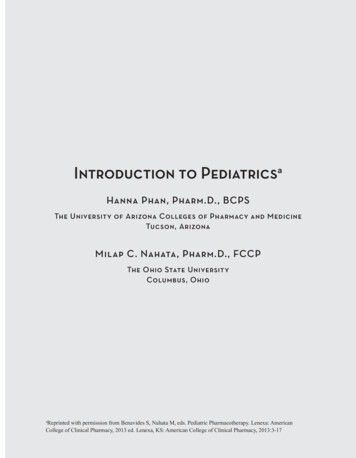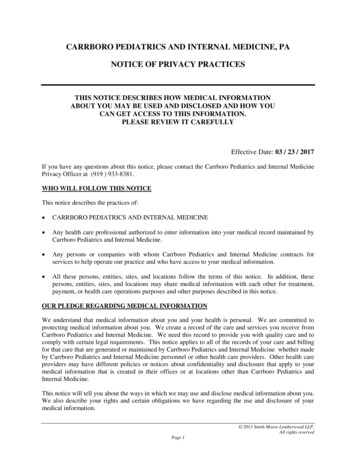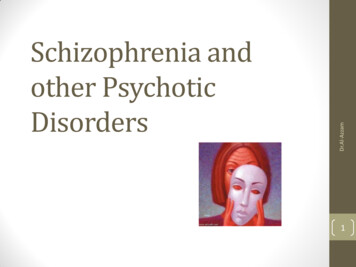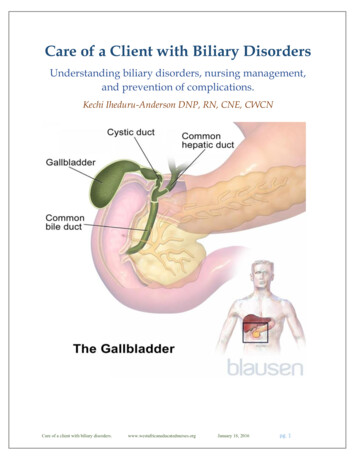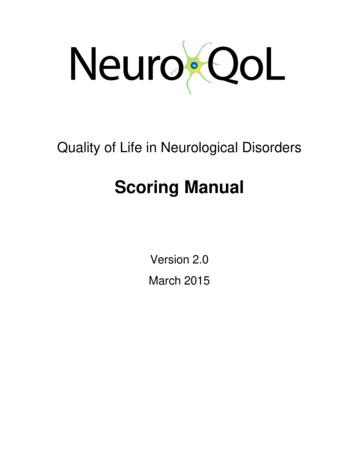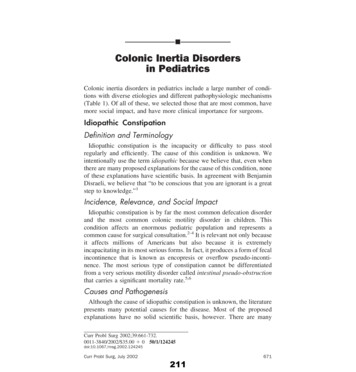
Transcription
Colonic Inertia Disordersin PediatricsColonic inertia disorders in pediatrics include a large number of conditions with diverse etiologies and different pathophysiologic mechanisms(Table 1). Of all of these, we selected those that are most common, havemore social impact, and have more clinical importance for surgeons.Idiopathic ConstipationDefinition and TerminologyIdiopathic constipation is the incapacity or difficulty to pass stoolregularly and efficiently. The cause of this condition is unknown. Weintentionally use the term idiopathic because we believe that, even whenthere are many proposed explanations for the cause of this condition, noneof these explanations have scientific basis. In agreement with BenjaminDisraeli, we believe that “to be conscious that you are ignorant is a greatstep to knowledge.”1Incidence, Relevance, and Social ImpactIdiopathic constipation is by far the most common defecation disorderand the most common colonic motility disorder in children. Thiscondition affects an enormous pediatric population and represents acommon cause for surgical consultation.2-4 It is relevant not only becauseit affects millions of Americans but also because it is extremelyincapacitating in its most serious forms. In fact, it produces a form of fecalincontinence that is known as encopresis or overflow pseudo-incontinence. The most serious type of constipation cannot be differentiatedfrom a very serious motility disorder called intestinal pseudo-obstructionthat carries a significant mortality rate.5,6Causes and PathogenesisAlthough the cause of idiopathic constipation is unknown, the literaturepresents many potential causes for the disease. Most of the proposedexplanations have no solid scientific basis, however. There are manyCurr Probl Surg 2002;39:661-732.0011-3840/2002/ 35.00 0 50/1/124245doi:10.1067/msg.2002.124245Curr Probl Surg, July 2002211671
TABLE 1. Cause of colonic inertia disorders in pediatricsIsolated defectsIdiopathic constipationColonic aganglionosis (Hirschsprung’s disease)Other conditionsIntestinal neuronal dysplasia (IND)Intestinal pseudo-obstructionVisceral neuropathiesVisceral myopathiesConsecutive to systemic diseasesScleroderma, lupus, diabetes mellitusHypothyroidism, hyperthyroidismLead poisoningDrugs: Opiates, anticholinergic ganglion blockers, aluminum, and calcium-containingantacidsCentral nervous system depression and hypoxiaNeuromuscular disease, muscular dystrophy“Prune belly” syndromeMental retardationMultiple endocrine neoplasia 2B syndromeDisturbed neuromuscular innervationSpina bifida, meningomyeloceleParaplegiaPostpolioSacral spinal cord tumorpublications that discuss dietary disorders as a cause of constipation.7,8There is no question that the different types of food that we ingest haveeither a laxative or constipating effect on the body. In addition, there arepersonal idiosyncracies that explain why one type of food may act as alaxative for one individual and as constipating for another individual. Werecognize that diet is important to regulate colonic motility, but thetherapeutic value of the diet is negligible in the most serious forms ofconstipation. Thousands of patients have mild forms of constipation thatare treated successfully with diet. However, the type of patient that isreferred to the surgeon has a much more serious form of this condition,a form that does not respond to dietary treatment.Many authorities have tried to explain the problem of idiopathicconstipation on a psychologic basis.9-14 Very interesting psychodynamicmechanisms have been proposed. Strict, demanding parents who imposerigid rules on a child during the toilet training process may provokepsychologic disturbances that result in idiopathic constipation. Children,then, supposedly, retain the stool to manipulate the parents to achievetheir own purposes. Many of these interesting mechanisms have anelement of truth, but we do not believe that they can explain the severe672212Curr Probl Surg, July 2002
forms of constipation in patients with a giant megacolon, a megabladder,and serious nutritional and developmental disturbances. In addition, it iscertainly not easy to retain the stool voluntarily when an otherwiseautonomous rectosigmoid has normal peristalsis. On the other hand, webelieve that most patients with idiopathic constipation have a secondarypsychologic component. This is true for most medical and surgicalconditions. Individuals who have an incapacity to empty the colon willhave serious psychologic distress. In addition, the passing of large, hardpieces of stool may provoke pain, which will make the patient afraid tohave bowel movements. This may complicate the problem of constipation, but we do not believe this is the original cause.Surgeons, on the other hand, have proposed different potential mechanisms to explain this problem. For instance, a rather simplistic explanation is that there is a lack of relaxation of the internal sphincter, alsoknown as achalasia.15-17 This is a very attractive and appealing idea. Inother words, a simplistic logic dictates that incontinence means lack ofsphincter, therefore, constipation means too much sphincter. However,the diagnosis of this achalasia of the internal sphincter is based mainly onmanometric studies.18-22 Unfortunately, rectal manometry is rather unreliable when analyzed and scrutinized carefully. Traditionally, rectalmanometry is performed by the placement of a balloon in the rectumwhen the pressure of the anal canal is being measured. When the rectalballoon is inflated under normal circumstances, there is a drop in theintra-anal canal pressure. This is well known in the literature as ananorectal reflex. When the pressure does not drop in the anal canal, it isconsidered abnormal and a sign of a lack of relaxation of the internalsphincter. This is also considered diagnostic for Hirschsprung’s disease.If the patient’s rectum has no ganglion cells, the diagnosis of Hirschsprung’s disease is confirmed. On the other hand, if the rectal biopsyshows ganglion cells, the patient then receives the diagnosis of achalasiaof the internal sphincter. In cases of Hirschsprung’s disease, the treatmentis well established and accepted. In cases of achalasia of the internalsphincter, the treatment proposed by many authorities is a myectomy orinternal sphincterectomy, which is a controversial procedure.23-25 Thewhole issue becomes more controversial when the rectal manometry isscrutinized critically. The pressure recorded in the lumen of the analcanal, supposedly given by the internal sphincter, in reality is generatedboth by the internal (smooth muscle) and by the striated voluntary musclemechanism (external sphincter and levator) that surrounds the lowerrectum and the anal canal around the area of the internal sphincter.26,27Curr Probl Surg, July 2002213673
We have been unable to find a publication that clarifies this serious flawin the interpretation of manometric studies.How do we know that the pressure in the anal canal is not the primaryresult of the contraction of the voluntary sphincter mechanism? Theoriginal manometric studies that were performed in animals used musclerelaxants, which kept the voluntary muscle mechanism paralyzed. Anychanges in the pressure of the anal canal under those circumstances couldbe attributed to the effect of the smooth muscle (internal sphincter).However, none of the clinical studies that have been published have beenperformed with the use of muscle relaxants. In addition, the inflation of aballoon in the rectum is assumed to produce tension on the rectal wallsthat triggers some form of mechanism that produces, as a final result, adrop of pressure in the lumen of the anal canal. However, the problemwith constipated patients is that they have different degrees of megarectosigmoid. Sometimes the megarectum is minimal, and sometimes it isgiant. The sizes of the balloons that are used in manometric studies arenever big enough to stretch giant rectosigmoids. As a result, it isconceivable that the inflation of a regular balloon is not enough to stretchthe rectal wall in patients with megarectum and may produce falsenegative relaxation reflexes.We do not use the sphincter myotomies that are proposed for thetreatment of internal sphincter achalasia23-25 because the descriptions ofthe surgical technique are not accurate and because the precise anatomiclimits of the internal sphincter are not well documented. Most importantly, the results of such operations have not been uniformly good.28There are many publications that favor the idea that intestinal neuronaldysplasia (IND) may be the explanation for the abnormal colon motilitythat is observed in patients who are constipated.29-34 We are ratherskeptical about this. A critical, comprehensive evaluation of the literatureon IND was conducted35; the most obvious impression that we obtainedfrom this review was that there is no basic agreement among pathologistsabout how to establish this specific histologic diagnosis. In addition,topographic studies that describe the extension of this histologic disorderin different patients are missing. For a surgeon to propose a rationaltreatment for this condition, the surgeon should know the extent of theaffected bowel that would be resected and, in theory, that will cure thepatient. This has never been accomplished. In addition, the symptoms ofpatients with IND vary from patient to patient. The treatments vary fromlaxatives to enemas to different types of resections, and the follow-up ofthe patients has not been consistent. To complicate the problem evenmore, some patients recover spontaneously. We believe that neuronal674214Curr Probl Surg, July 2002
intestinal dysplasia represents an interesting histologic disorder thatdeserves further scientific evaluation.Hypoganglionosis has also been invoked as a potential explanation forpatients with severe constipation. This is based on biopsy specimens thatwere taken from specimens of dilated colon. However, as far as we know,the number of ganglion cells remains constant through our lifetime. If thatis true and the colon becomes larger and larger as the constipationproblem gets worse, it is conceivable that a specimen taken from thecolon from a giant megasigmoid will show relatively fewer ganglioncells, which could explain a diagnosis of (relative) hypoganglionosis.Many surgeons believe that many patients with idiopathic constipationmay have ultra short Hirschsprung’s disease.36,37 They believe that somepatients may have a very short area above the anal canal with absentganglion cells that produces constipation and that may explain the reasonthat the rectum is dilated all the way down to the anal canal. Again, thisis also an attractive but controversial explanation. The problem with thisconcept is that normal individuals have an area of aganglionosis above thepectinate line. The length of that area has not been described accurately.There have been attempts to determine the extent of this area, but thesestudies have not been comprehensive.38,39 A study that determines thelength of normal aganglionosis in premature infants, newborns, preschoolchildren, school-aged children, adolescents, and adults has not beenperformed.Once the diagnosis of ultra short-segment Hirschsprung’s disease hasbeen established, the proposed treatment is a posterior rectal myectomy.There is no explanation about why such an operation may improve thesymptoms in these patients. In addition, the results of these operations aredebatable.28More recently, we have learned about new potential explanations forcolonic hypomotility. A deficiency of substance P immunoreactivity inthe colonic nerve fibers of some children with severe constipation hasbeen proposed.40 In addition, abnormalities were found in the colon whenit was studied with monoclonal antineurofilament antibodies.41 Anothervery interesting finding was an increased plasma level of pancreaticpolypeptide and a decreased plasma level of motilin in children withencopresis.42 All of these new possibilities deserve future investigation.We recognize that we do not yet know the cause of this condition. Webelieve that these patients are born with a form of hypomotility disorder,with different degrees of severity and a wide spectrum of symptoms.43,44At the benign end of the spectrum, some patients have a minor form ofconstipation that is treatable with diet alone. At the other extreme, weCurr Probl Surg, July 2002215675
encounter patients with severe forms of constipation that may overlapclinically with a serious condition known as intestinal pseudo-obstruction,and they may even die. In the very severe form of this condition, patientsfrequently have not only the incapacity to empty the rectum but also theincapacity to empty the bladder, without any recognizable spinal orneurologic abnormality. They have some form of severe autonomicdisorder of unknown origin.The concept of a spectrum of disease cannot be over-emphasized. Mostof the proposed treatments for constipation45-50 do not take this intoconsideration, but rather they are standard therapeutic protocols thatrender good results in a percentage of cases but that always leave a groupof patients who do not respond.51-59 This group (that we call medicallyintractable) represents the most serious portion of the spectrum.Natural History and Clinical ManifestationsAlthough we do not know the cause of idiopathic constipation, we havelearned a great deal about its natural history. Idiopathic constipation is aself-perpetuating and self-aggravating disease. A patient who has acertain degree of constipation and who is not treated adequately goesthrough life only partially emptying the colon, leaving larger and largeramounts of stool inside the rectosigmoid, which results in greater degreesof megasigmoid.Most surgeons accept the common clinical fact that the dilatation of ahollow viscus produces poor peristalsis. Constipation, or fecal retention,that p
Once the diagnosis of ultra short-segment Hirschsprung’s disease has been established, the proposed treatment is a posterior rectal myectomy. There is no explanation about why such an operation may improve the symptoms in these patients. In addition, the results of these operations are debatable.28

